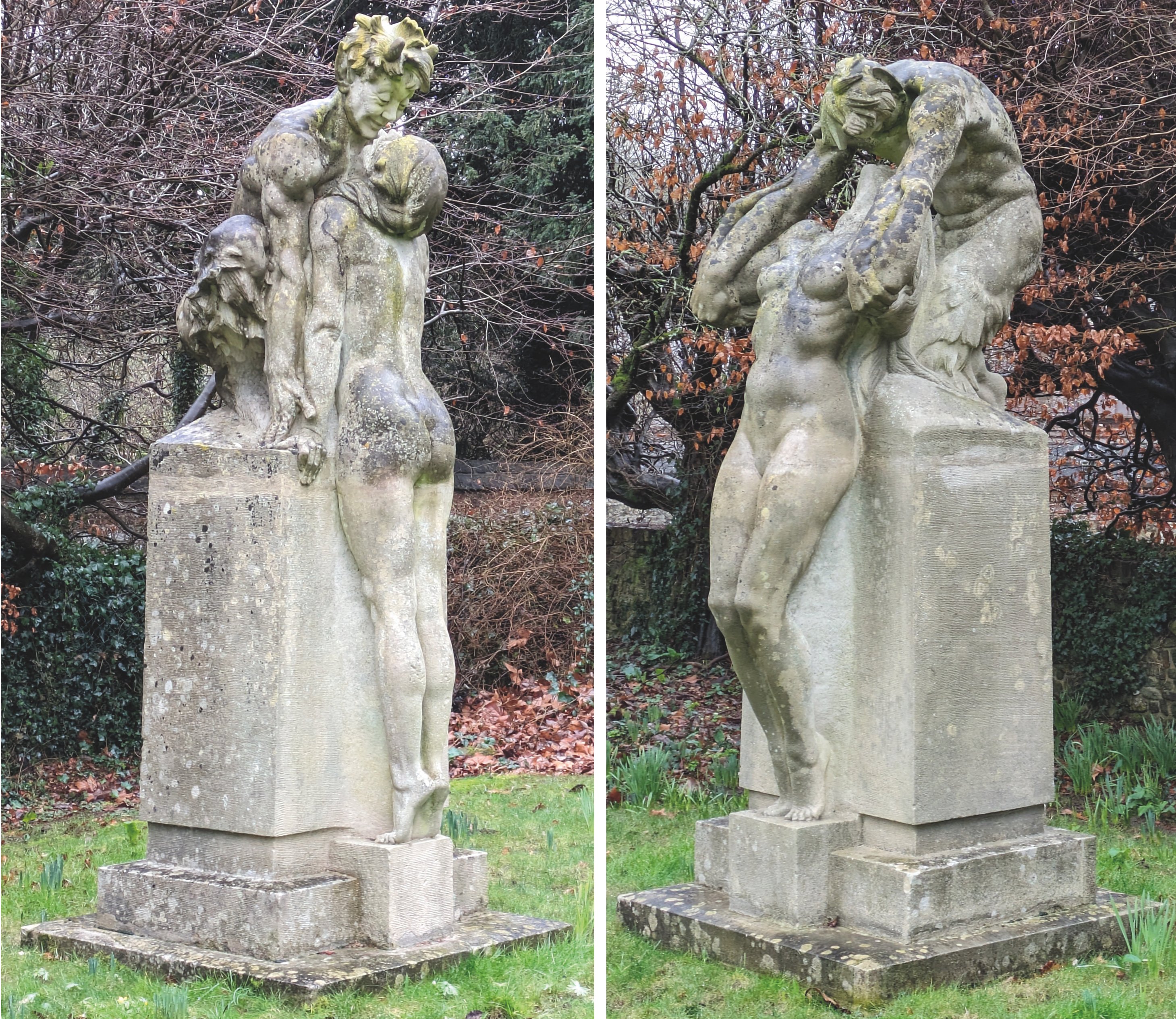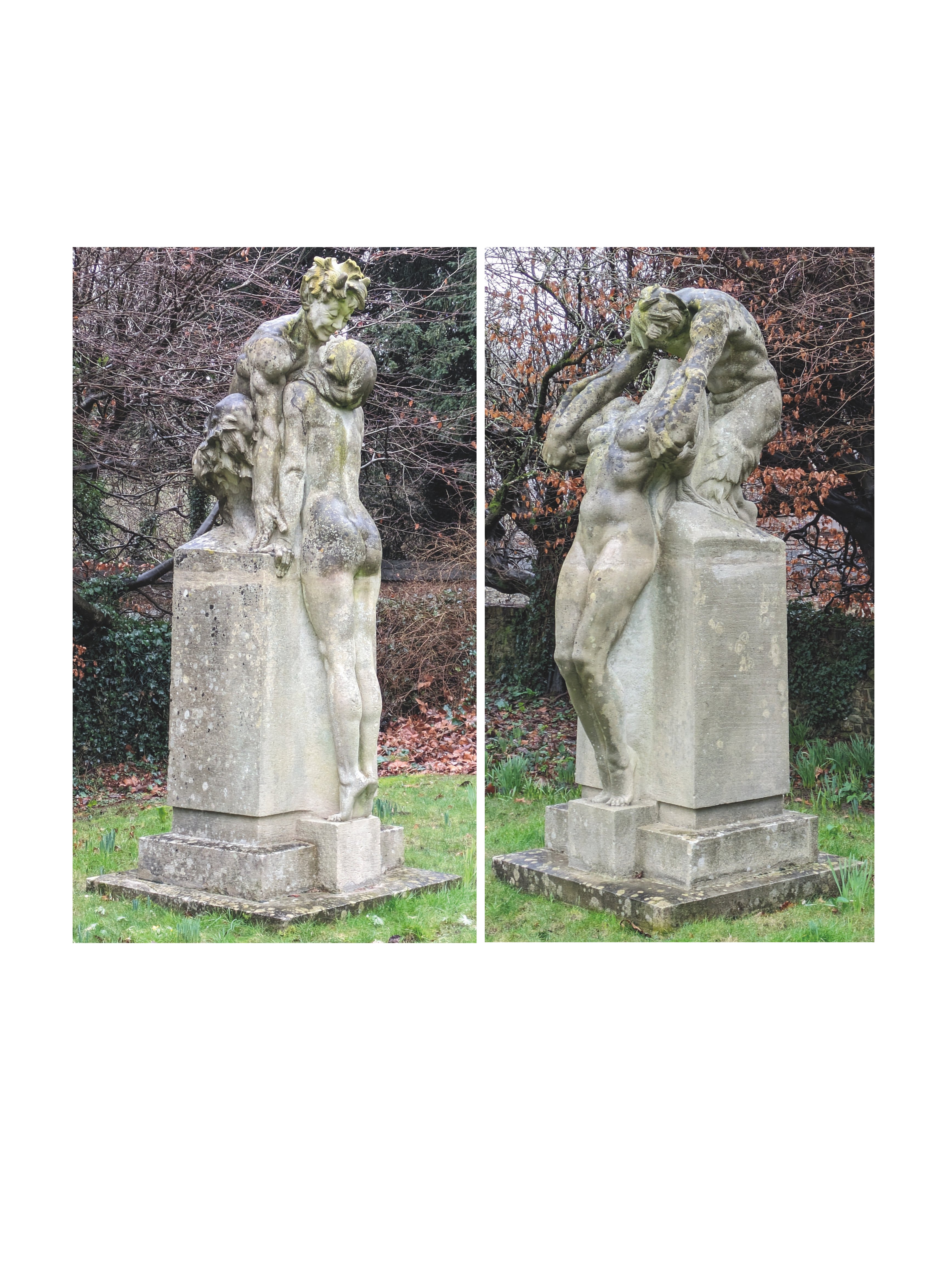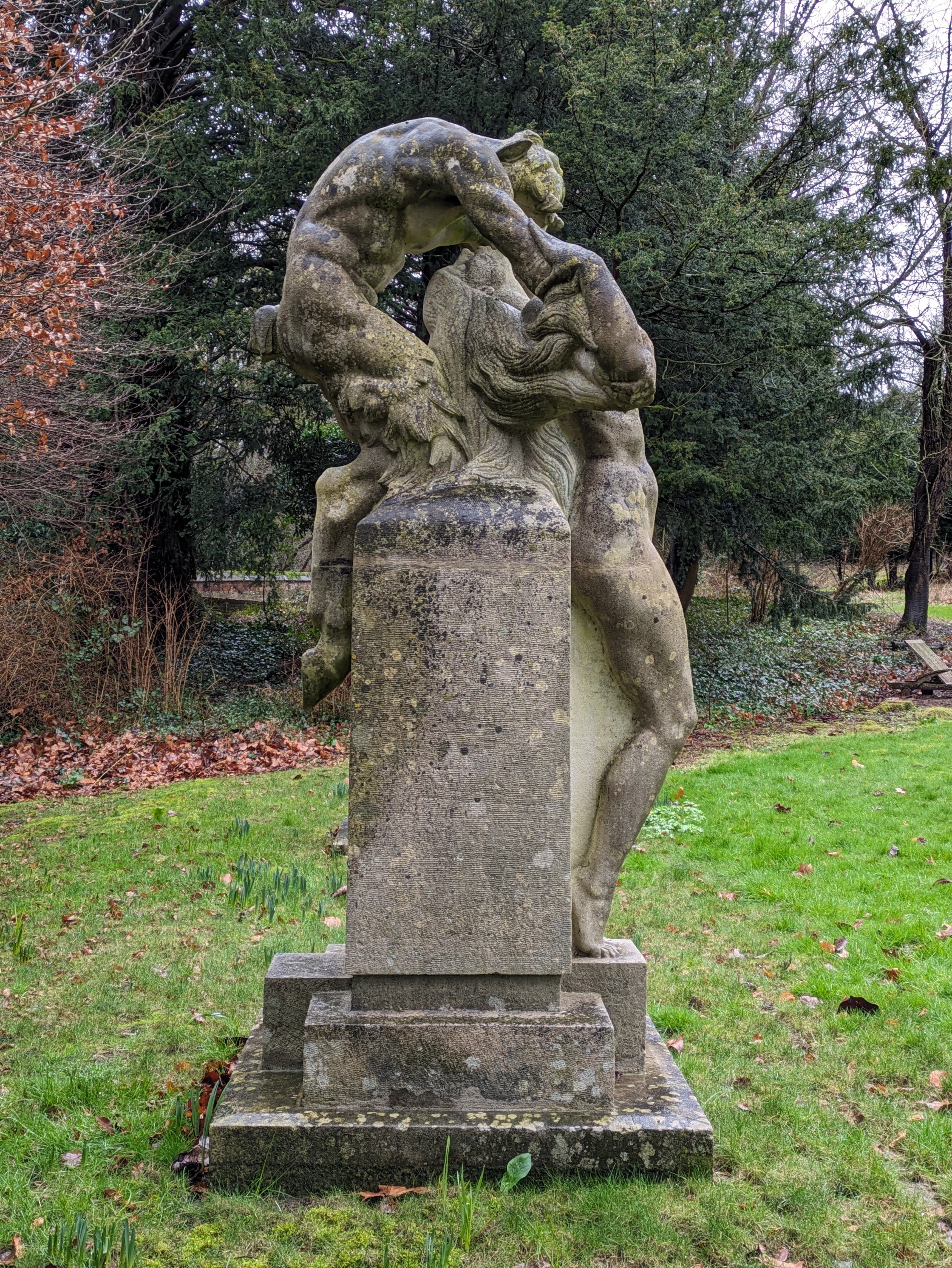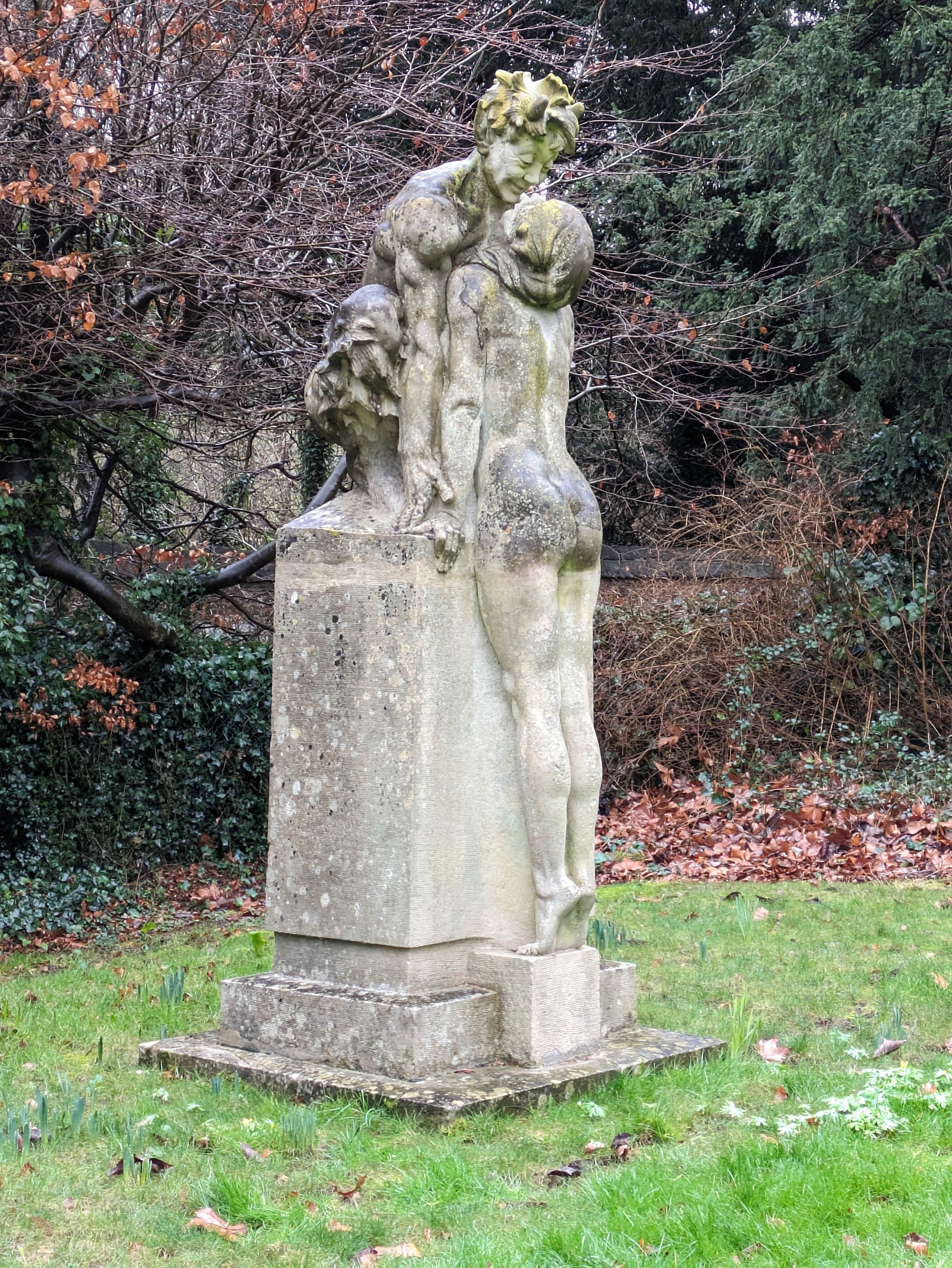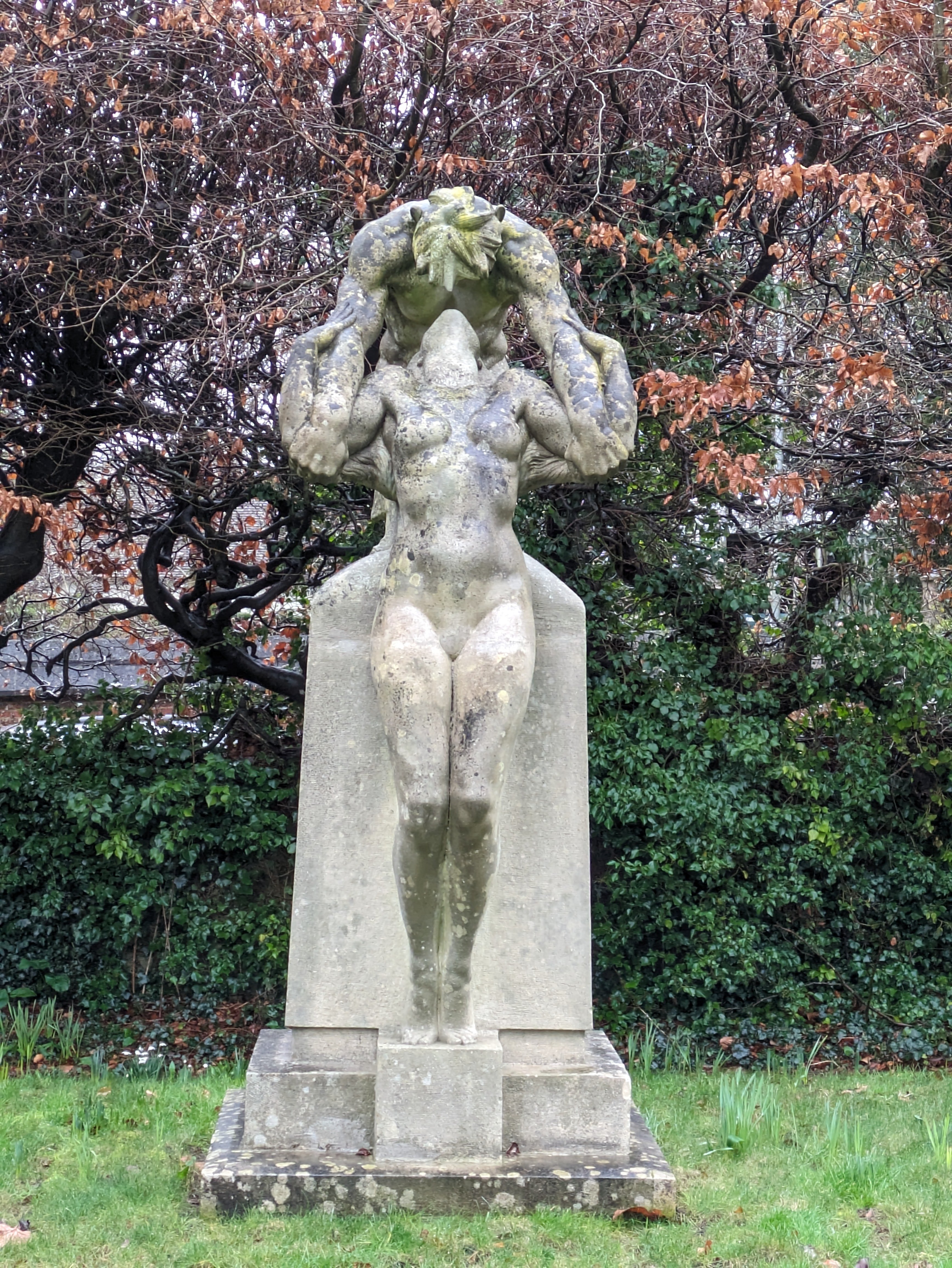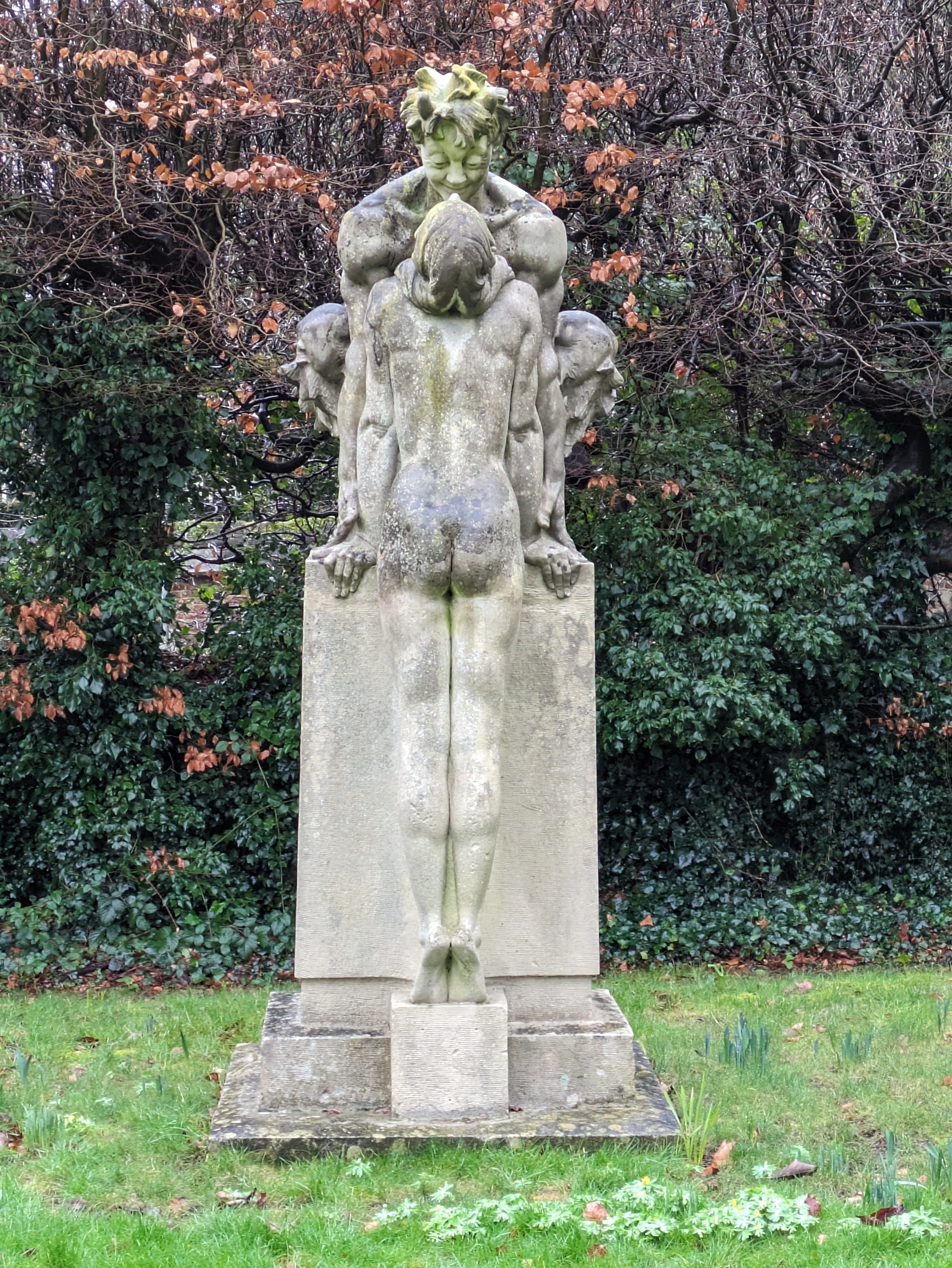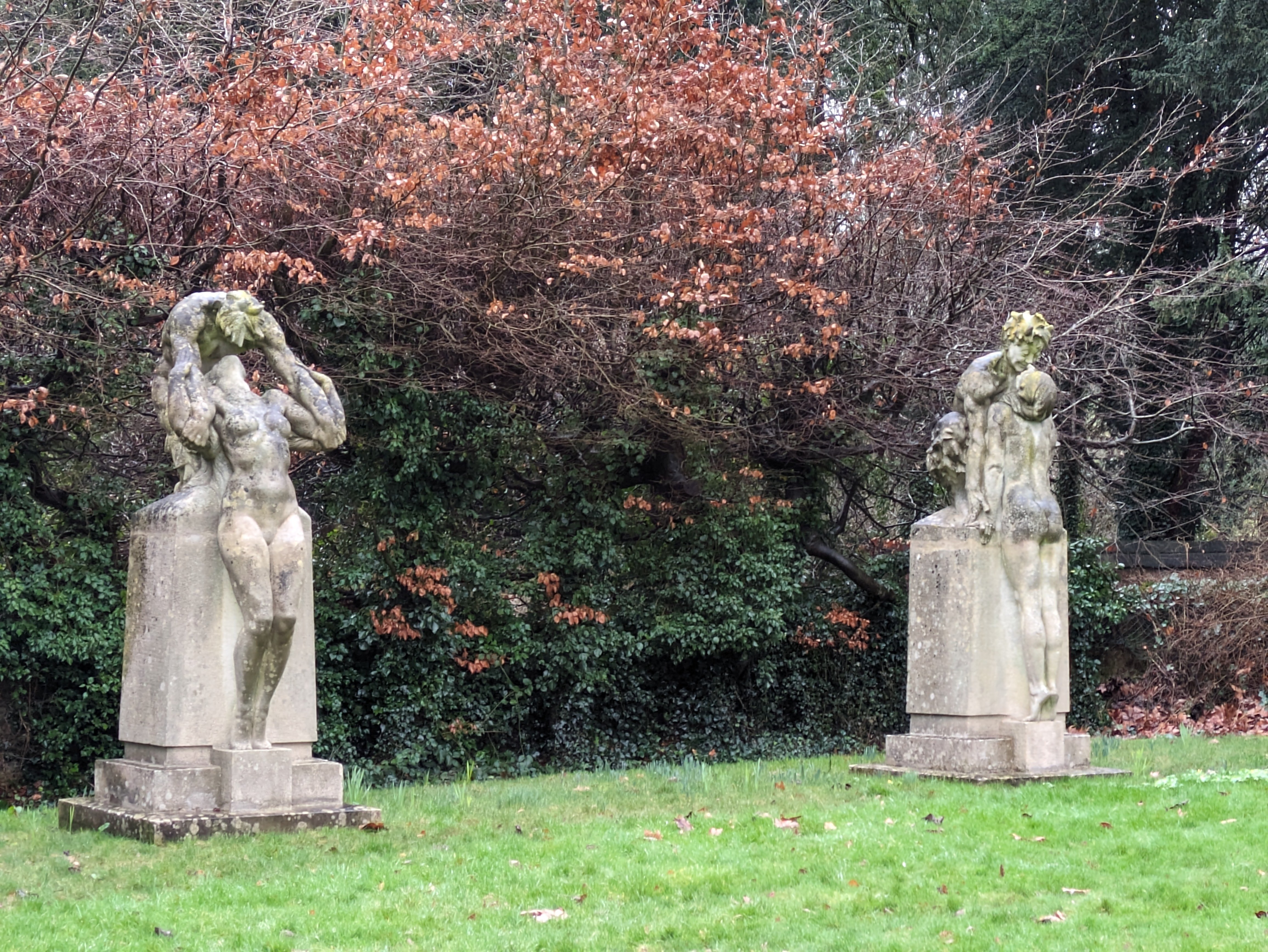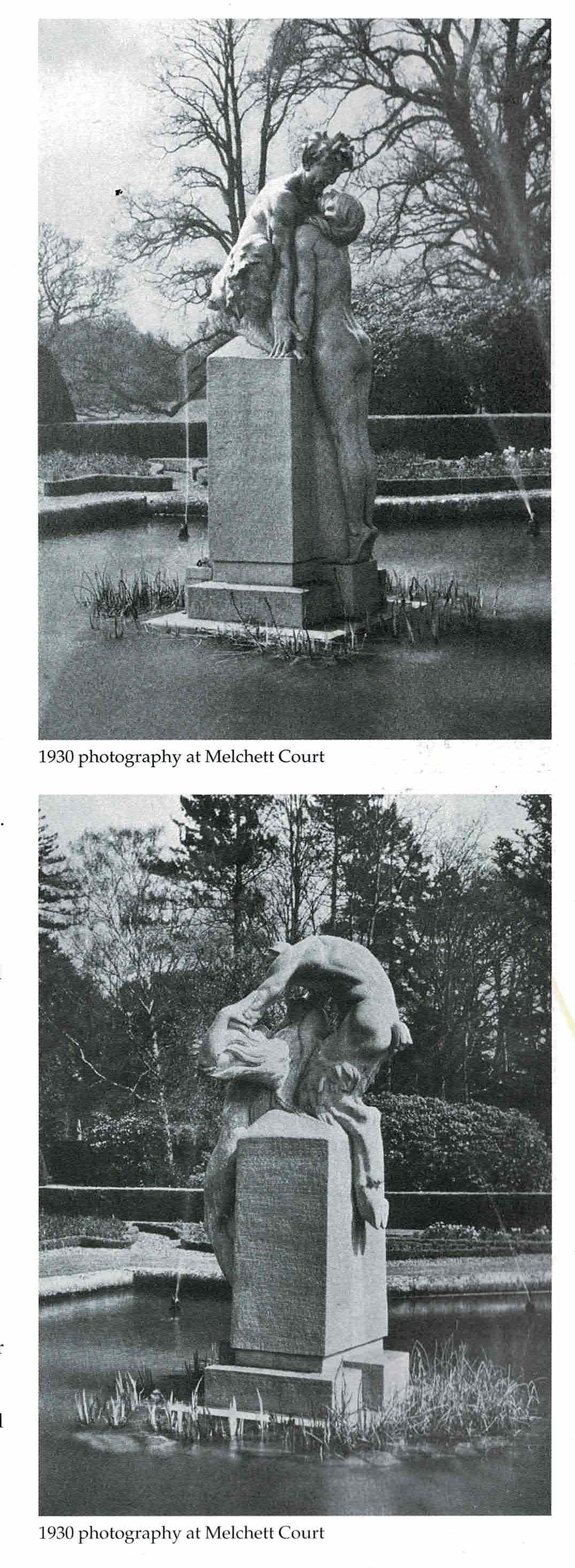12
Charles Sargeant Jagger (1885-1934) A pair of rare Portland stone groups of a nymph and satyr
Charles Sargeant Jagger (1885-1934) A pair of rare Portland stone groups of a nymph and satyr
each in the form of a satyr carved with curly hair and cloven hooves squatting on a tapering square pedestal and leaning over a naked nymph, one with the nymph with flowing hair facing towards him and raising herself on tiptoe to offer a kiss, the other with the nymph leaning backwards the satyr grasping her arms and pulling her up towards his embrace, 350cm high
*** This lot is being sold insitu - appointments can be made to view***
Provenance: Melchett Court, Hampshire, 1927
Alfred 1st Lord Melchett Colworth, Bedfordshire 1936, Henry 2nd Lord Melchett, Beale Park, Berkshire, 1948Charles Sargeant Jagger was born at Kilnhurst, Yorkshire on 17th December 1885, the second child of Mary (née Sargeant) and Enoch Jagger, he had a younger brother David who later became a society portrait painter, and an older sister Edith, who also became a gifted painter. Their father was a colliery manager. In 1907 he was awarded a scholarship by West Riding county council to study at the Royal College of Art. Under Professor Lanteri he achieved considerable success including a major college travel bursary which enabled him to visit Italy and North Africa in 1911.
In 1914 he was awarded the Prix de Rome, with a relief entitled Bacchanalian Scene. The romantic classical feeling of his work at this time was not to be repeated until the late 1920’s when the Melchett Court groups were commissioned. Before he could take up his scholarship in Rome war was declared and Jagger made a considerable personal sacrifice by renouncing it and instead enlisting in the Artists Rifles.
In 1915 he sailed with the British Expeditionary Force to Gallipoli. In the most appalling conditions, he was eventually shot through the shoulder and shipped out to a hospital in Malta. He was subsequently posted to the Front in France and in April 1918 was badly wounded at the Battle of Neuve Église. In recognition of his valour he was awarded the Military cross. Whilst he was convalescing a friend at the Royal College of Art told him that the British War Memorials Committee were about to employ sculptors. In 1919 Sir George Frampton (who had been on the panel judging the Rome scholarship) recommended him to design a memorial planned for Hoylake and West Kirby, Lancashire. This proved a turning point in his career, and between 1921 and 1923 he completed six war memorials and started on his most well-known work, the Royal Artillery memorial at Hyde Park Corner. All of these are characterized by the same brutal and grim, but also massively strong treatment of the soldiers or ‘Tommies’. His recorded comments on war memorials repeat the basic notion of ‘showing the Tommy as I knew him in the trenches’. There followed a number of other commissions both at home and abroad for the Imperial War Graves Commissions. By the second half of the 1920’s Jagger’s eminence as a sculptor had become established. The Royal Artillery Memorial had a somewhat mixed reception when it was unveiled in 1925, but nevertheless secured Jagger’s name as a public figure. In 1926 he became an associate of the Royal Academy and was awarded a medal by the Royal Society of British Sculptors. At this time Jagger also built up an influential circle of patrons, including Sir Edwin Lutyens, who also became a close friend, and Sir Stephen Courtauld, who commissioned two decorative plaques from him. He was also commissioned to do a statuette of H.R.H. the Prince of Wales. The Prince was known to have admired Jagger’s work and commissioned a cast of one of Jagger’s bronzes. ‘Wipers’ in 1921. This informal portrait of the Prince portrayed holding a tennis racquet was considered one of Jagger’s finest works and helped him avoid being stereotyped as a war memorial sculptor. It was also at this time that Jagger began his association with Sir Alfred Mond, the first Lord Melchett, and his son Henry. Sir Alfred served on the council of the British School at Rome from 1925, but already knew Jagger’s work. It is likely that they got to know each other as a result of the work Jagger did for the British War Memorials commission. Mond was heavily involved in setting up the Imperial War Museum which took over the commissions made by the B.W.M.C. at the end of 1918 and so probably saw Jagger’s work at that time. Certainly, from the early 1920’s the Mond family were active supporters of Jagger’s work and from this association there emerged a close relationship between them. Charles Jagger and Henry Mond, who were almost the same age, were particularly close and the Jaggers often visited the Monds at their Hampshire home. Amongst the many commissions the Mond family gave Jagger, were the sculptures on Imperial Chemical House. This building, a well-known London landmark on the River Thames at Millbank, was designed by Sir Frank Baines to provide the central offices of I.C.I. when it was formed out of a merger between companies belonging to the Mond family and to Sir Harold McGowan in 1926. Jagger produced four massive sculptures typifying great industries of the world, Agriculture, Marine Transport, the Building Industry and Chemistry. At around the same time Jagger was commissioned by Lord Melchett to carve this pair of Portland stone groups of nymphs and satyrs for his home, Melchett Court, Hampshire. These form an important part of a small group of privately commissioned works on literary and classical themes. In a similar vein Jagger produced a relief based on Sheridan’s School for Scandal for Henry and Gwen Mond’s drawing room at Mulberry House, Smith Square, London. This features a man embracing a naked woman. Also, a pair of reliefs for Sir Stephen Courtauld circa 1930 feature a nymph and a satyr mocking an elderly satyr who is offering jewels to the young nymph. The Melchett Court satyrs and nymphs are the only known work by Jagger in which he explores this romantic classical approach with its mildly erotic overtones in a large-scale three-dimensional way. The salacious expression of the squatting and kneeling satyrs contrasts brilliantly with the yearning expressions of the nymphs with their languid nubile bodies. The gentle satire employed in these works is striking because of the contrast it makes with the serious subject matter of much of Jagger’s work. It reinforces the view that he felt no obligation to be predictable concerning the content of his work. The Courtauld reliefs and the Melchett Court nymphs and satyrs also reveal that Jagger’s romantic temperament, which is evident in this works prior to 1914, had not been entirely crushed by his experiences during the War. All the same, these later works are easily distinguishable from the earlier classical reliefs by their boldness and simplicity of form which is distinctly Art Deco. Jagger died in November 1934 at the early age of 48. Between 1918 and 1934 Jagger produced some 45 works, most of which were war memorials or commissions for large buildings. These groups are amongst the most important of the private commissions which he undertook. Following his death these two groups were exhibited in the Charles Sargeant Jagger Memorial Exhibition at the Royal Society of Painters in watercolours in Pall Mall, on 21st May to 20th June 1934. The chairman was Lord Melchett. The exhibition list also includes small bronzes of the nymphs and satyrs priced at 25 guineas each, which presumably were maquettes for the full-size groups. Sadly, no price is given for these, however since they formed an integral part of Melchett Court it is doubtful whether they would have been for sale. A plaster...
Charles Sargeant Jagger (1885-1934) A pair of rare Portland stone groups of a nymph and satyr
each in the form of a satyr carved with curly hair and cloven hooves squatting on a tapering square pedestal and leaning over a naked nymph, one with the nymph with flowing hair facing towards him and raising herself on tiptoe to offer a kiss, the other with the nymph leaning backwards the satyr grasping her arms and pulling her up towards his embrace, 350cm high
*** This lot is being sold insitu - appointments can be made to view***
Provenance: Melchett Court, Hampshire, 1927
Alfred 1st Lord Melchett Colworth, Bedfordshire 1936, Henry 2nd Lord Melchett, Beale Park, Berkshire, 1948Charles Sargeant Jagger was born at Kilnhurst, Yorkshire on 17th December 1885, the second child of Mary (née Sargeant) and Enoch Jagger, he had a younger brother David who later became a society portrait painter, and an older sister Edith, who also became a gifted painter. Their father was a colliery manager. In 1907 he was awarded a scholarship by West Riding county council to study at the Royal College of Art. Under Professor Lanteri he achieved considerable success including a major college travel bursary which enabled him to visit Italy and North Africa in 1911.
In 1914 he was awarded the Prix de Rome, with a relief entitled Bacchanalian Scene. The romantic classical feeling of his work at this time was not to be repeated until the late 1920’s when the Melchett Court groups were commissioned. Before he could take up his scholarship in Rome war was declared and Jagger made a considerable personal sacrifice by renouncing it and instead enlisting in the Artists Rifles.
In 1915 he sailed with the British Expeditionary Force to Gallipoli. In the most appalling conditions, he was eventually shot through the shoulder and shipped out to a hospital in Malta. He was subsequently posted to the Front in France and in April 1918 was badly wounded at the Battle of Neuve Église. In recognition of his valour he was awarded the Military cross. Whilst he was convalescing a friend at the Royal College of Art told him that the British War Memorials Committee were about to employ sculptors. In 1919 Sir George Frampton (who had been on the panel judging the Rome scholarship) recommended him to design a memorial planned for Hoylake and West Kirby, Lancashire. This proved a turning point in his career, and between 1921 and 1923 he completed six war memorials and started on his most well-known work, the Royal Artillery memorial at Hyde Park Corner. All of these are characterized by the same brutal and grim, but also massively strong treatment of the soldiers or ‘Tommies’. His recorded comments on war memorials repeat the basic notion of ‘showing the Tommy as I knew him in the trenches’. There followed a number of other commissions both at home and abroad for the Imperial War Graves Commissions. By the second half of the 1920’s Jagger’s eminence as a sculptor had become established. The Royal Artillery Memorial had a somewhat mixed reception when it was unveiled in 1925, but nevertheless secured Jagger’s name as a public figure. In 1926 he became an associate of the Royal Academy and was awarded a medal by the Royal Society of British Sculptors. At this time Jagger also built up an influential circle of patrons, including Sir Edwin Lutyens, who also became a close friend, and Sir Stephen Courtauld, who commissioned two decorative plaques from him. He was also commissioned to do a statuette of H.R.H. the Prince of Wales. The Prince was known to have admired Jagger’s work and commissioned a cast of one of Jagger’s bronzes. ‘Wipers’ in 1921. This informal portrait of the Prince portrayed holding a tennis racquet was considered one of Jagger’s finest works and helped him avoid being stereotyped as a war memorial sculptor. It was also at this time that Jagger began his association with Sir Alfred Mond, the first Lord Melchett, and his son Henry. Sir Alfred served on the council of the British School at Rome from 1925, but already knew Jagger’s work. It is likely that they got to know each other as a result of the work Jagger did for the British War Memorials commission. Mond was heavily involved in setting up the Imperial War Museum which took over the commissions made by the B.W.M.C. at the end of 1918 and so probably saw Jagger’s work at that time. Certainly, from the early 1920’s the Mond family were active supporters of Jagger’s work and from this association there emerged a close relationship between them. Charles Jagger and Henry Mond, who were almost the same age, were particularly close and the Jaggers often visited the Monds at their Hampshire home. Amongst the many commissions the Mond family gave Jagger, were the sculptures on Imperial Chemical House. This building, a well-known London landmark on the River Thames at Millbank, was designed by Sir Frank Baines to provide the central offices of I.C.I. when it was formed out of a merger between companies belonging to the Mond family and to Sir Harold McGowan in 1926. Jagger produced four massive sculptures typifying great industries of the world, Agriculture, Marine Transport, the Building Industry and Chemistry. At around the same time Jagger was commissioned by Lord Melchett to carve this pair of Portland stone groups of nymphs and satyrs for his home, Melchett Court, Hampshire. These form an important part of a small group of privately commissioned works on literary and classical themes. In a similar vein Jagger produced a relief based on Sheridan’s School for Scandal for Henry and Gwen Mond’s drawing room at Mulberry House, Smith Square, London. This features a man embracing a naked woman. Also, a pair of reliefs for Sir Stephen Courtauld circa 1930 feature a nymph and a satyr mocking an elderly satyr who is offering jewels to the young nymph. The Melchett Court satyrs and nymphs are the only known work by Jagger in which he explores this romantic classical approach with its mildly erotic overtones in a large-scale three-dimensional way. The salacious expression of the squatting and kneeling satyrs contrasts brilliantly with the yearning expressions of the nymphs with their languid nubile bodies. The gentle satire employed in these works is striking because of the contrast it makes with the serious subject matter of much of Jagger’s work. It reinforces the view that he felt no obligation to be predictable concerning the content of his work. The Courtauld reliefs and the Melchett Court nymphs and satyrs also reveal that Jagger’s romantic temperament, which is evident in this works prior to 1914, had not been entirely crushed by his experiences during the War. All the same, these later works are easily distinguishable from the earlier classical reliefs by their boldness and simplicity of form which is distinctly Art Deco. Jagger died in November 1934 at the early age of 48. Between 1918 and 1934 Jagger produced some 45 works, most of which were war memorials or commissions for large buildings. These groups are amongst the most important of the private commissions which he undertook. Following his death these two groups were exhibited in the Charles Sargeant Jagger Memorial Exhibition at the Royal Society of Painters in watercolours in Pall Mall, on 21st May to 20th June 1934. The chairman was Lord Melchett. The exhibition list also includes small bronzes of the nymphs and satyrs priced at 25 guineas each, which presumably were maquettes for the full-size groups. Sadly, no price is given for these, however since they formed an integral part of Melchett Court it is doubtful whether they would have been for sale. A plaster...
Home, Garden & Natural History (Live)
Sale Date(s)
Venue Address
Summers Place Auctions are happy to arrange shipping quotations and have extensive experience in working in conjunction with leading domestic and international shippers. There is no charge for arranging quotations. We are happy to provide advice on any lots, to overseas buyers concerning export restrictions. However, it is ultimately the buyers responsibility to satisfy themselves that the correct licenses can be obtained prior to bidding.
All collections and deliveries are strictly by prior appointment only. Please book in at least 48 hours in advance. Collections are between the hours of 9am-4pm by appointment.
Whilst we will do our best to have lots ready for collection, carriers/buyers must also supply sufficient labour to load purchased pieces without any additional help from our staff, other than loading pieces on pallets with our forklift truck.
Important Information
Live - This is a live auction with an auctioneer. Bidding is available by Commission/Absentee and Telephone bidding, using the online platform the-saleroom.com (5% surcharge) or using the new Summers Place Live
Lots 1-52 are in the live auction (26th March 2024)
Lots 100-266 are in the sealed bid auction (27th March 2024) - see separate listing
Viewing is strictly by appointment only.
Credit or debit cards for payment are not accepted, we encourage bank transfers.
Buyers Premium payable by the buyer of each lot is at a rate of 25% on the first £250,000, then 20% on the amount by which the hammer price exceeds £250,000, plus an amount in respect of VAT thereon.
Lots with a † symbol – These lots will be sold under the normal UK VAT rules and VAT will be charged at 20% on both the hammer price and buyer’s premium. Lots with a ‡ symbol – These lots have been imported under TI subject to 5% import VAT .Lots with ▲ These lots are subject to a payment of the Artist’s Resale Right at a percentage of the hammer price.
Please note that all lots are sold subject to our conditions of business for buyers and authenticity guarantee, which are available from Summers Place Auctions office on request.
Shipping
Summers Place Auctions are happy to arrange shipping quotations and have extensive experience in working in conjunction with leading domestic and international shippers. There is no charge for arranging quotations. We are happy to provide advice on any lots, to overseas buyers concerning export restrictions. However, it is ultimately the buyers responsibility to satisfy themselves that the correct licenses can be obtained prior to bidding.
Free online live bidding through 'Summers Place Live' is available for this sale (No surcharge - normal BP and VAT apply). To register for this facility, or to leave absentee bids, visit the home screen and click on Register (top right hand corner) or click on the green 'Register to Bid' button below a lot - Artist Resale Right applies to all Lots with a ▲ symbol -- VAT on the hammer price applies to all Lots with a † symbol
Terms & Conditions
The Conditions of Business for Sellers govern all aspects of the consignment, report, holding and sale of Property by Summers Place Auctions Limited together with Summers Place Auctions Limited’s Authenticity Guarantee and the Conditions of Business for Buyers, as printed in sale catalogues and available from Summers Place Auctions Limited upon request. Summers Place Auctions Limited act as agent for Sellers.
Conditions of Business for Buyers and/or Sellers may be amended by additional terms printed in the sale catalogue and/or by notices posted up in the saleroom or announced by the auctioneer.
DEFINITIONS
“Seller” is the owner of the Property, their agent, executors or the person in possession of the Property (as appropriate).
“SPA” means Summers Place Auctions Limited, Auctioneers, The Walled Garden, Stane Street, Billingshurst,West Sussex, RH14 9AB, company number 6266518.
“Seller’s Commission” is the commission Summers Place Auctions Limited charges Sellers of Property.
“Expenses” are Summers Place Auctions Limited’s expenses, fees and charges relating to the Property, including legal expenses, insurance charges, illustration fees, administration fees, customs duties, shipping and packing costs, tests, searches and enquiries.
“Buyer’s Premium” is the commission Summers Place Auctions Limited charges Buyers of Property.
“Hammer Price” is the highest bid for the Property accepted by the auctioneer and for simplicity, the highest bid above the reserve received for the sealed bid auctions.
“Reserve Price” is the minimum Hammer Price at which the Property may be sold, as agreed between the Seller and Summers Place Auctions Limited. From time to time, Summers Place Auctions Limited may agree with the Seller to offer a collection of Property for a Global Reserve Price and/or agree an auctioneer’s discretion to reduce the Reserve Price by 10% or to offer Property without a Reserve Price.
“Net Sale Proceeds” are the proceeds of sale actually received by Summers Place Auctions Limited, less Seller’s Commission, Buyer’s Premium and Expenses.
The Seller’s Commission, Hammer Price, Buyer’s Premium and all Expenses are subject to VAT, where applicable.
1. SELLER’S WARRANTIES
(a) The Seller warrants to SPA and the Buyer that:-
(i) the Seller is the owner of the Property or is properly authorised to sell it;
(ii) the Seller shall transfer possession and good title in the Property to the Buyer, free from any third party claims;
(iii) the Seller has provided all relevant information about the ownership, condition, authenticity, attribution, provenance and import/export history of the Property;
(iv) there are no copyright or other restrictions on SPA’s rights to produce and publish images of the Property.
(v) for property being consigned from outside the E.U. that the item has been lawfully and permanently exported as required by the laws of any country in which it was located prior to consignment to SPA and that any duties and taxes on the export and import of the item have been paid.
(b) The Seller will indemnify SPA, its directors, employees, officers and Buyers of the Property against all losses and damages resulting from a breach of any of these warranties or other Conditions of Business. SPA may cancel, rescind or postpone sales of Property where it reasonably believes that there has been or may be a breach of these warranties or any other Conditions of Business by the Seller.
2. SALE PREPARATION
(a) SPA shall have sole discretion as to how Property is described, illustrated and marketed, and the date, venue and conduct of the sale.
(b)[i] All oral or written estimates, appraisals and reports are statements of opinion only, may not be relied upon as a prediction of the sale price and may be revised from time to time by SPA.
[ii] The seller acknowledges that attribution of items is a matter of opinion and not fact, and is dependant upon (amongst other things): information provided by the seller, and the status of generally accepted expert opinion at the time of cataloguing.
(c) SPA may, without obligation, consult with third party experts and carry out such other research for the Property as it deems necessary and has vendors aucthority to apply for any CITES documentation. SPA may transfer possession of the Property to such third parties and shall not be responsible for the acts and omissions of such third parties.
(d) SPA shall have the absolute right to produce and publish images of any Property consigned for sale and will retain copyright in any such images it produces.
(e) SPA will charge a Buyer’s Premium on the sale of the Property at SPA’s standard rates. SPA reserves the right to pay out of its commissions a fee to any third party introducing Sellers or Property to it.
(f) Sellers are prohibited from bidding on their own Property. If a Seller offers the Hammer Price for their Property, SPA may charge the Seller the Seller’s Commission, Buyer’s Premium and Expenses relating to that Property.
3. SELLER’S COMMISSION
Sellers commission applies to each lot plus VAT
No unsold charges apart from a nominal £25 + VAT photography charge per lot per auction.
All charges subject to VAT at the prevailing rate
4. WITHDRAWAL OF LOTS
(a) If the Seller withdraws any Property from sale after their written agreement to sell it, SPA may charge the Seller 50% of the Seller’s Commission and Buyer’s Premium SPA would have received had the Property sold at its mid estimate, plus all Expenses (the “Withdrawal Fee”).
(b) SPA may withdraw any Property from sale without liability for any of the following reasons:- if (i) it reasonably believes that the authenticity or attribution is questionable; (ii) it reasonably believes that the Seller’s Warranties or other Conditions of Business have been breached; (iii) there is a competing ownership claim or lien over the Property; (iv) the Property does not have all licences and permits required by law, including those required under the Convention on the International Trade in Endangered Species (CITES); (v) the condition of the Property has deteriorated since consignment; (vi) the auction has been postponed for any reason.
(c) If the Property is withdrawn for any of reasons 3(b)(ii), or (iii) the Seller shall pay the Withdrawal Fee, as per Condition 3(a). If withdrawn for any other reason, the Property shall be returned to the Seller at the Seller’s expense.
5. EXCLUSION OF LIABILITY
(a) SPA shall not be liable for any errors or omissions in any written or oral information provided to Sellers or for acts or omissions relating to the conduct of the auction or any other matter relating to the sale of Property, whether negligent or otherwise, subject always to Condition 4(c).
(b) Without prejudice to Condition 4(a), any claim against SPA shall be limited to the Net Sale Proceeds for the relevant Property. SPA shall not in any circumstances be liable for any indirect or consequential losses.
(c) SPA’s liability to the Seller in respect of death or personal injury caused by SPA’s negligent acts or omissions shall not be excluded or limited.
6. LOSS OR DAMAGE TO PROPERTY
(a) Unless otherwise agreed in writing, SPA will assume the risk of loss or damage to Property received from the Seller until:-
(i) risk passes to the Buyer at the fall of the hammer, or when the successful bidder is invoiced by SPA for lots in the sealed bid auction. or
(ii) if unsold, 30 days after the sale or when released to the Seller (whichever is earlier); or
(iii) 6 months after receipt of the Property by SPA, if not consigned for sale.
(b) The seller agrees to pay a charge for the above liability accepted by SPA for which SPA shall charge a premium of 0% of:-
(i) the Hammer Price of the Property, if sold; or
(ii) the mid estimate, if not offered for sale (or SPA’s reasonable estimate of auction value where there are no pre-sale estimates).
(c) If damage or loss occurs whilst the Property is at the risk of SPA, the maximum amount of SPA’s liability shall be as set out in Condition 5 (b) (i)- (iii), as applicable, less Seller’s Commission and Expenses.
(d) SPA will not be liable for any loss or damage caused by:- (i) normal wear and tear, gradual deterioration or inherent vice or defect; (ii) errors in processing; (iii) war, radioactive contamination or acts of terrorism.
7. POST- AUCTION SALES
If any Property fails to sell at auction, SPA shall be entitled for a period of 35 days after the auction to sell the Property privately for no less than the Reserve Price (unless otherwise agreed with the Seller) and on the terms of these Conditions of Business. Any reference in the conditions of business to the auction date shall be treated as the date of the post-auction sale
8. PAYMENT OF NET SALE PROCEEDS
(a) A sale contract is made directly between the Buyer and the Seller. SPA’s sole obligation shall be to send the seller Net Sale proceeds once appropriate identification and cleared funds have been received from the buyer. Subject in all cases to prior receipt of cleared funds by SPA and subject to rescission of the sale under Condition 9, 35 days after the sale date or 5 working days after receipt of cleared funds from the Buyer (whichever is later), SPA shall send the Seller the Net Sale Proceeds in sterling, less any other amounts owed by the Seller to SPA.
(b) SPA shall not be obliged to check the ability of Buyers to pay for Property and shall have absolute discretion whether to use any of the rights and remedies against defaulting Buyers contained in the Conditions of Business for Buyers.
9. UNSOLD/ UNCOLLECTED PROPERTY
(a) SPA will advise Sellers whether or not their Property has sold. Unsold Property may either:-
(i) be reconsigned for sale with an automatic reduction of 30% on the original reserve, unless by prior agreement with SPA; or
(ii) collected by the Seller, once relevant expenses have been settled.
(b) If the Seller does not reconsign or collect the Property within 60 days of the auction as per Condition 8(a) (i) or (ii) above, SPA shall be released from any duty of bailment and may in its sole discretion be entitled to:-
(i) transfer the Property to independent storage at the Seller’s expense; or
(ii) re-offer the Property at auction for no less than 50% of the original Reserve Price agreed with the Seller (where applicable), and subject to the Seller’s Commission on the re-sale plus all relevant Expenses.
(c)[i] If the Seller deposits the Property with SPA for more than 1 year and neither collects or consigns it for sale, SPA shall be entitled to sell such Property at a SPA sale or elsewhere, with estimates and reserves at SPA’s discretion, after giving the Seller 60 days written notice sent to the Seller’s last known address.
[ii] Any resale of unsold lots shall be conducted under these conditions of business, save only that, between the Seller and SPA, these conditions of business shall continue to apply and prevail in the event of any conflict. The proceeds of such sale less all costs incurred by SPA will be forfeited unless collected by the Seller within two years of the sale.
10. RESCISSION OF SALES
SPA may rescind the sale where it reasonably believes that the Property is Counterfeit, as defined by SPA’s Guarantee of Authenticity, in which case SPA shall send the Seller a notice of such rescission. The Seller agrees to return to SPA the Net Sale Proceeds received from the sale of such Property together with any additional Expenses incurred by SPA. SPA will return the Property to the Seller upon receipt of the Net Sale Proceeds and Expenses, unless prevented from doing so for reasons beyond SPA’s control.
11. DATA PROTECTION
(a) SPA will use information supplied by Sellers or otherwise obtained lawfully by SPA for the provision of auction related services, client administration, marketing and as otherwise required by law.
(b) By agreeing to these Conditions of Business, the Seller agrees to the processing of their personal information and to the disclosure of such information to third parties world-wide for the purposes outlined in Condition 10(a).
(c) Clients please note that for security purposes, SPA premises are subject to video monitoring and telephone calls may also be recorded.
(d) If you would not like to receive details of future events please tick here. □
12. MISCELLANEOUS
(a) If any part of these Conditions of Business be held unenforceable, the remaining parts shall remain in full force and effect.
b) These Conditions of Business shall be interpreted in accordance with English Law under the exclusive jurisdiction of the English Courts, in favour of SPA.
(c) In accordance with market practice, SPA reserves the right to pay out of its commissions a fee to any third party introducing clients or property to it.


















.png)
